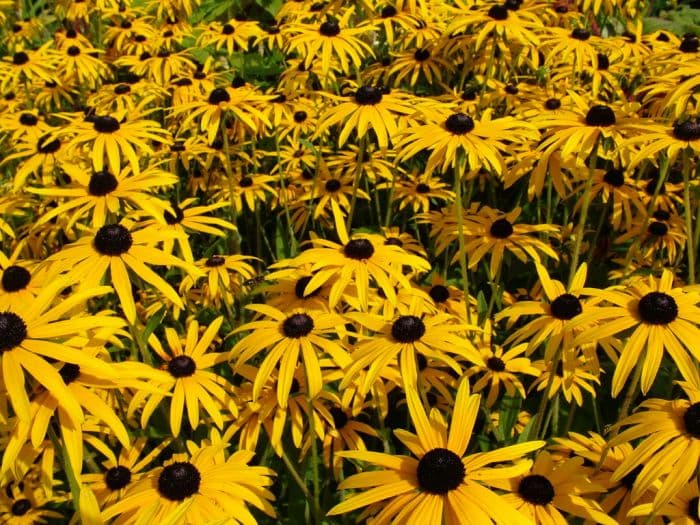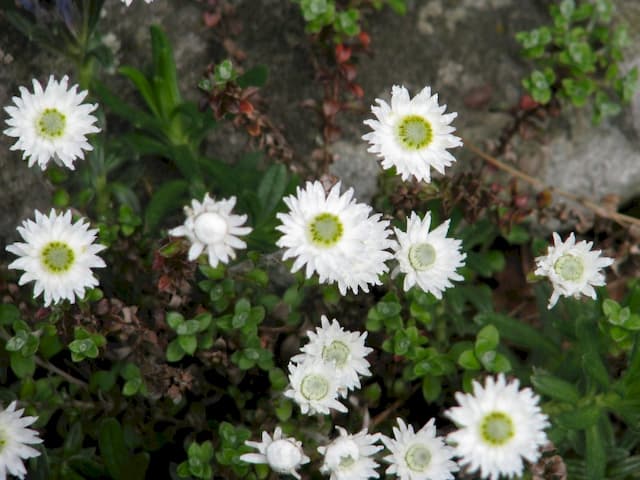Black-eyed Susan Rudbeckia fulgida

ABOUT
Rudbeckia fulgida, commonly known as the Black-eyed Susan, is a striking perennial plant that is well-known for its vibrant and cheerful flowers. The most prominent feature of this plant is its daisy-like blooms, which boast a central, dark brown or almost black cone surrounded by bright yellow to golden petals. These petals are typically long, numerous, and radiate outwards from the cone in a symmetrical pattern, creating an eye-catching contrast. The leaves of the Black-eyed Susan are usually deep green in color and have a slightly hairy texture. They grow in an alternating pattern along the plant's stems, which are sturdy and upright. The leaves are lance-shaped or oblong, sometimes with toothed or slightly serrated edges, giving them a textured appearance. The overall look of the Black-eyed Susan is lush and full, providing a long-lasting display of blooms from late summer to fall. The flower heads attract a variety of pollinators, including bees and butterflies, adding to the overall allure of the plant in a garden setting. Its appearance exudes a wildflower charm that can add warmth and brightness to any landscape.
About this plant
 Names
NamesFamily
Asteraceae.
Synonyms
Orange Coneflower, Black-eyed Susan, Eastern Coneflower, Orange Black-eyed Susan, Perennial Coneflower.
Common names
Rudbeckia fulgida var. sullivantii, Rudbeckia speciosa, Rudbeckia speciosa var. sullivantii
 Toxicity
ToxicityTo humans
Black-eyed Susan is generally considered non-toxic to humans. It is not known to contain any compounds that would typically cause poisoning or adverse reactions upon ingestion. However, as with any plant material, individual allergies or sensitivities could result in mild stomach upset if ingested. It is always advisable to be cautious and refrain from eating any plant parts unless they are known to be edible and safe.
To pets
Black-eyed Susan is also generally considered non-toxic to pets, including dogs and cats. It does not typically pose a risk of poisoning if pets consume parts of the plant. However, individual animals may react differently, and ingestion could potentially lead to mild gastrointestinal upset, such as vomiting or diarrhea, particularly if consumed in large quantities. As with humans, it is wise to prevent pets from eating plants that are not intended for consumption.
 Characteristics
CharacteristicsLife cycle
Perennials
Foliage type
Deciduous
Color of leaves
Green
Flower color
Yellow
Height
2-3 feet (60-90 cm)
Spread
1-2 feet (30-60 cm)
Plant type
Herb
Hardiness zones
3-9
Native area
North America
Benefits
 General Benefits
General Benefits- Attracts Wildlife: Rudbeckia fulgida, commonly known as Black-eyed Susan, is known for attracting butterflies, bees, and other beneficial insects, which are essential for pollination.
- Aesthetic Appeal: It adds vibrant yellow and orange colors to gardens and landscapes with its daisy-like flowers, enhancing visual interest.
- Drought Tolerance: Black-eyed Susan is relatively drought-resistant once established, making it suitable for xeriscaping or areas with water restrictions.
- Low Maintenance: It is generally easy to care for, requiring minimal maintenance, which is ideal for both novice gardeners and professionals.
- Erosion Control: The plant has a fibrous root system that helps stabilize soil and prevent erosion, especially on sloped areas.
- Long Blooming Period: Black-eyed Susan offers a long season of bloom, from midsummer to autumn, providing long-term vibrancy in the garden.
- Wildlife Food Source: The seeds of the plant are a food source for birds during the fall and winter when other resources are scarce.
- Adaptability: It can thrive in a variety of soil types and environmental conditions, making it a versatile choice for different landscapes.
 Medical Properties
Medical PropertiesThis plant is not used for medical purposes.
 Air-purifying Qualities
Air-purifying QualitiesThis plant is not specifically known for air purifying qualities.
 Other Uses
Other Uses- Rudbeckia fulgida, commonly known as Black-eyed Susan, can be used in natural dye production, yielding colors from bright yellows to greenish hues depending on the mordant used.
- Insect attraction in gardens to promote pollination, as Black-eyed Susan flowers are known for attracting butterflies and bees.
- Erosion control due to their robust root system which can help stabilize soil, particularly on slopes or in areas where ground cover is needed.
- Habitat restoration as Black-eyed Susan is native to North America and can be used in projects aiming to restore natural plant communities.
- Educational tool in botany and ecology classes for studying plant structure, native species, and pollinator relationships.
- Companion planting in agricultural practices, since they can lure beneficial insects that help control crop pests.
- Seasonal decoration for festive arrangements and bouquets due to their bright, cheerful flowers that last well when cut.
- Symbolic use in native traditions and ceremonies, where they represent encouragement and motivation.
- Garden design as a natural border plant due to their tendency to form dense clumps.
- Photography subject for capturing the diverse insect life they attract, contributing to biodiversity documentation.
Interesting Facts
 Feng Shui
Feng ShuiBlack-eyed Susan is not used in Feng Shui practice.
 Zodiac Sign Compitability
Zodiac Sign CompitabilityBlack-eyed Susan is not used in astrology practice.
 Plant Symbolism
Plant Symbolism- Justice: Rudbeckia fulgida, commonly known as Black-eyed Susan, is associated with justice, reflecting its use in traditional Native American culture where it was thought to bring fairness and equity.
- Optimism: Black-eyed Susans radiate cheer with their bright yellow petals resembling the sun, symbolizing positivity and a belief in a good, bright future.
- Encouragement: The plant is often given to encourage someone going through a tough time, representing support and the strength to face challenges.
- Survival: As a hardy perennial that stands tall even in adverse conditions, the Black-eyed Susan symbolizes resilience and the power of survival.
 Water
WaterBlack-eyed Susans require consistent moisture, especially during their blooming period in summer and fall. Water these plants once or twice a week, deeply enough so that water penetrates the top 6-8 inches of soil. A good rule of thumb is about one inch of water weekly, which equates to approximately 0.623 gallon for every square foot of soil. During particularly hot or dry periods, you may need to water more frequently to maintain soil moisture. It's best to water early in the morning to reduce evaporation and allow the foliage to dry out during the day, which helps prevent diseases.
 Light
LightBlack-eyed Susans thrive in full sun conditions where they can receive at least six hours of direct sunlight daily. They perform best in a spot that is bright and sunny, although they can tolerate some light partial shade, especially in areas with particularly hot afternoon sun.
 Temperature
TemperatureBlack-eyed Susans are hardy in a wide range of temperatures and can tolerate a minimum temperature of around -30°F once established. They thrive in typical garden conditions with temperatures between 60°F and 70°F but can survive up to 90°F or more during summer months. To promote vigorous growth and abundant flowering, placing them in an area that doesn’t experience extreme temperature fluctuations is ideal.
 Pruning
PruningPruning Black-eyed Susans improves their appearance and promotes healthy growth. Deadheading, or cutting off spent flowers, encourages more blooms and prevents the plants from self-seeding excessively. In the fall, after flowering has finished, you can cut back the stems to a few inches above the ground to tidy up the plant and prepare it for winter. Perform major pruning and deadheading during the growing season as needed to keep the plants looking their best.
 Cleaning
CleaningAs needed
 Soil
SoilBlack-eyed Susan thrives in well-draining soil enriched with organic matter, with a preferred pH range of 5.8 to 6.8. A mix of loamy soil, peat, and perlite or sand can create an ideal growing medium.
 Repotting
RepottingBlack-eyed Susan, being a perennial, doesn't typically require repotting. This plant is usually left undisturbed to grow in the garden or is divided every 3-4 years to maintain vigor.
 Humidity & Misting
Humidity & MistingBlack-eyed Susan is tolerant of a wide range of humidity levels and thrives in average outdoor conditions without needing specific humidity adjustments.
 Suitable locations
Suitable locationsIndoor
Place in bright indirect light, ensure good airflow.
Outdoor
Full sun, well-draining soil, space 18 inches apart.
Hardiness zone
3-9 USDA
 Life cycle
Life cycleRudbeckia fulgida, commonly known as Black-eyed Susan, starts its life cycle as a seed, which germinates in spring when the soil temperature warms up. The seed develops into a seedling, which then grows into a young plant with a rosette of leaves close to the ground. As the plant matures, it develops a strong root system and erect stems, and by late spring to early summer, it starts to produce flower buds. The buds bloom into the characteristic bright yellow flowers with a black or brown central cone during the summer months. After pollination, usually by insects, the flowers produce seeds by late summer or fall. The plant then enters a period of dormancy during the winter, with the cycle starting again with seed germination the following spring.
 Propogation
PropogationPropogation time
Late summer to fall
The most popular method of propagation for the Black-eyed Susan (Rudbeckia fulgida) is by seed. Propagation from seed is typically done in the spring after the threat of frost has passed. The seeds should be sown on the surface of a well-draining soil mix and lightly pressed into the soil for good contact since they need light to germinate. Keep the soil evenly moist, but not waterlogged. Germination should occur in 7 to 30 days at a temperature of about 70 degrees Fahrenheit (21 degrees Celsius). Once seedlings have grown large enough to handle, usually when they have a couple sets of true leaves, they can be transplanted into individual pots or directly into the garden. To encourage a more robust root system, seedlings can be pinched back when they are 4 to 6 inches tall.
![Dahlia [American Pie]](/_next/image?url=https%3A%2F%2Fplants-admin.emdemapps.com%2Fimages%2Fplants%2F%2Fimages%2F604b646522398.png&w=640&q=75)








